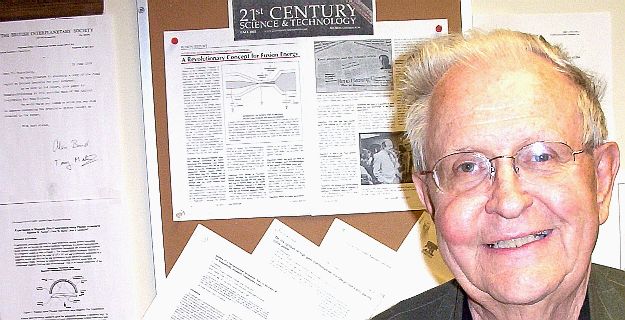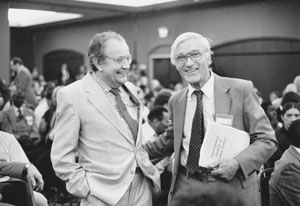
Friedwardt Winterberg

LINKS PUBLICATIONS PLANCK AETHER HEIZENBERG'S LETTER OPERATED FUSION INTERVIEW RUSSIAN
|
SCHEMATIC OF DEVICE FOR ACHIEVING
A small, conically shaped target of deuterium-tritium fuel is placed at the juncture of two magnetically insulated transmission cables. A high voltage and relatively low current in the cable at left heats the tip of the cone to thermonuclear temperatures. A high current and relatively low voltage in the cable at the right generates a magnetic field pressure (marked H in the diagram), which contains the deuterium-tritium, and causes a shock wave to move to the right, up the fuel cone, igniting the rest of the fuel without the need for any more confinement.
Some of the press flap generated by the 1981 publication of Professor Winterberg's book , The Physical Principles of Thermonuclear Explosions, and its coverage in 21st Century's predecessor magazine, Fusion.  The author (left) with plasma physicist Winston Bostick at a 1985 memorial conference for space scientist Krafft Ehricke, organized by Lyndon H. LaRouche, Jr., and his wife, Helga Zepp-LaRouche. Stuart Lewis/EIRNS |
Alive classicist - father of nuclear rocket engine and electric discharge nuclear fusion, professor Friedwardt Winterberg, Dr. rer. nat., was bom in Germany in 1929, got his Ph.D. degree in 1955 under Nobel laureate Werner Heisenberg, became a professor of physics at the State University of Nevada in 1963 and U.S. citizen in 1968. He was awarded the 1979 Hermann Oberth Gold Medal of the Werner von Braun International Space Right Foundation for his work in nuclear rocket propulsion, and is an elected member of the International Academy of Astronautics. More than 200 papers of him are published in recognized refereed scientific journals and two books. In 1954, he proposed for the first time to test Einstein's general theory of relativity with atomic clocks placed in earth satellites, many years before artificial satellites became a reality. At this time in Hamburg, Germany, he made the first design studies for the nuclear ship propulsion reactor of the "Otto Hahn". His paper on nonuniform fuel distributions in nuclear reactors, Geneva 1958, contains the theory which was used for the design of the NERVA nuclear rocket engine (and was translated into Russian immediately). Much later Soviet NPO "Luch" organization practised soviet version of such engine in Kazakhstan, on Semipalatinsk Test Site. Other important contributions are in the field of inertial confinement fusion. There he is credited with the concept of impact fusion through the acceleration of a superconducting projectile to ultrahigh velocities (Journal of Nuclear Energy 1966). The same idea was applied many years later by others for advanced space technologies in what is known as the mass driver. F. Winterberg is also credited with the concept of the magnetically insulated diode for the generation of ultraintense, magampere-megavolt, ion beams (published 1969). This concept is under active development all over the world by many large government laboratories as a driver for inertial confinement fusion. This invention is not restricted to fusion, and apart from a variety of other applications has been considered as a potential beam weapon concept for the Strategic Defense Initiative (SDI). Because of this important invention, F. Winterberg obtained in 1981 a citation by the Nevada Legislature. Another concept proposed by F. Winterberg led to the recognition that very short wave length lasers in the gamma energy range and below, are possible in principle. At the present he is working on his Planck ether theory. As he states, only further calculations and experiments can decide about the correctness of this approach, which, if true, would have far reaching consequences for all of physics and natural philosophy. |